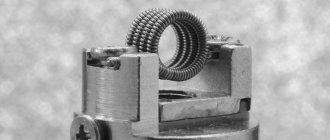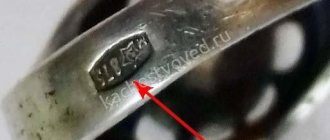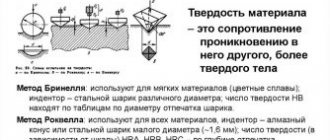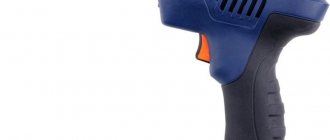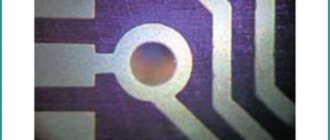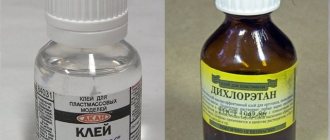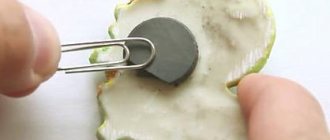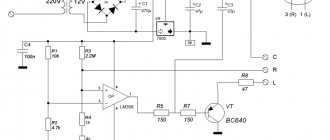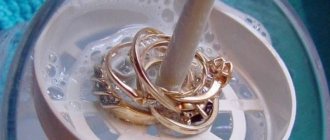What is nichrome?
Nichrome is a corrosion-resistant alloy consisting of 2 metals - nickel and chromium, and additives (manganese, sulfur, aluminum, phosphorus, iron, etc.). The alloy is resistant to temperatures up to +1300⁰C, and its plasticity allows it to be used for the production of electric heating and resistive elements, various rolled products and wire (thread). Depending on the composition, nichrome is divided into certain grades.
Characteristics and properties of nichrome wire
The production of nichrome wire is limited to two main grades: X15H60 and X20H80 . The characteristics and properties of each brand are different.
X20H80 is characterized by:
- Composition of 25% chromium, 75% nickel, 1% iron.
- Specific resistance 1.13 Ohm mm 2 /m (for wire with a diameter over 3 mm).
- Operating temperature 1250⁰C-1300⁰C.
The density of X20H80 is 8500 kg/m³, the specific heat capacity is 0.44 kJ/(kg K).
X15H60 is inferior to X20H80 in terms of technical characteristics:
- operating temperature – 1000⁰C-1100⁰C;
- composition – 18% chromium and 60% nickel;
- specific heat capacity – 0.46 kJ/(kg K);
- density 8200 - 8500 kg/m³;
The resistivity of this brand is 1.12 Ohm mm 2 /m.
The low iron content of X20H80 allows the thread to exhibit resistance to corrosion and wear. Unlike X15H60, which is more susceptible to corrosion. However, this brand serves for the production of samples, the cross-section of which is characterized by greater ductility and smaller area.
REFERENCE . As filler elements, both grades can include aluminum, manganese, titanium, silicon, iron and zirconium. At the same time, the presence of iron increases the magnetic properties of the alloy.
Properties and applications of nichrome
An alloy of nickel and chromium in a ratio of 80 to 20 obtained in 1905 , thanks to its technical properties, has found application in many devices and products. Despite the high cost of the resulting material, obvious benefits were observed due to the durability and trouble-free operation of the devices.
The percentage ratio of nickel-chromium was selected experimentally and solved the set goal: to achieve properties of the metal that were not provided by any of those used in technology at that time.
Advantageous characteristics of nichrome:
- plasticity (an important property in the production of nichrome products);
- heat resistance;
- low expansion coefficient when exposed to high temperatures;
- does not create a significant electromagnetic field when operating products in electrical appliances:
- high current resistance (the main parameter for use in electric heating devices);
- small specific gravity.
Currently, the alloy composition may vary. Supplements may be added from:
The main brands of nichrome are X20N80 and X15N60 .
Products made from nickel-containing alloy:
- ribbon;
- rod;
- wire;
- certain types of fasteners;
- parts for operating devices under conditions of sudden and repeated temperature changes and (or) in an aggressive environment.
Where is nichrome wire used?
Plasticity, resistance to aggressive substances and high yield strength are used by nichrome in industrial production and a number of industrial areas where electric heating furnaces are widely used. The alloy has also found application in electric furnaces, the heating temperature of which is extremely high.
Wire is also used in other areas:
- in homemade welding machines;
- in ovens for drying and firing;
- for machines cutting foam plastic;
- in the heating system of car windows and mirrors;
- in devices where an increased degree of reliability is required, etc.
This property of the alloy, such as strength, has provided nichrome wire with a place in all environments where chemicals, heat and high temperatures are indispensable.
How to determine nichrome?
Nichrome, as a slightly silver or white material, is not easy to recognize. In addition, it often has a dark gray tint associated with an oxide (oxidizing) film.
However, it is possible to determine the appearance of the material by the following characteristics:
- dark green film on the surface;
- turning the wire into a spiral after heating.
The last sign indicates the high resistance of nichrome to deformation.
ATTENTION . The mode of alternating long-term and short-term use of the thread will help maintain the quality characteristics of nichrome wire.
Admission conditions and restrictions
When choosing a point for delivery of nichrome raw materials, you should pay attention to some information about the conditions for receiving a particular point.
The seller must pay attention
for the following points:
- The maximum declared value refers to an alloy in which the nickel content approaches 80%
, and scrap in its pure form (without dirt or chemical residues). - Is there a limit on the weight of the batch
(some have a minimum weight, for example, 500 kg). They will, of course, accept less, but the price will be reduced. - What method is used to check the nickel content in raw materials ().
Where can I find nichrome wire?
The easiest way to find nichrome wire is to go to a special store (vape shop). True, nichrome thread is not cheap there, and for 1 meter you will have to pay a decent amount.
There are other options where you can find nichrome wire:
- radio markets;
- soldering irons;
- hair dryers;
- fan-type heater;
- electric stove with open spiral;
- Internet.
The ability to detect metal on the radio market is not very great, compared to a soldering iron (working or faulty). A soldering device can be found in a garage, or in a Fix Price store, where the product costs a penny. To find what you are looking for, the device must be disassembled and the wire pulled out. As a rule, the nichrome thread in the soldering iron is thin. Winding 10 turns on a pencil will help determine its cross-section. The length of the wound wire reaches up to 2.5 m.
Sources of nichrome scrap
Modern heating equipment (household and industrial) contains products made of nichrome. High-resistance resistors , including ballast ones , are often made of this alloy.
A thrifty owner, before throwing away a device that cannot be repaired, will disassemble it and sort it by type of recyclable material. Then he will receive monetary compensation for his efforts.
A burnt-out radiator can be returned without disassembling it. In this case, it will be accepted at the price of regular scrap metal. But it also contains non-ferrous metals, albeit in small quantities.
By the components separately, the amount due will look much nicer .
In addition to privately owned equipment that allows you to extract nichrome parts and wire, there are other sources.
The most attractive are warehouses with surplus goods . It is not always possible to sell unclaimed items as products. The solution is to hand over it as non-ferrous metal.
When product certificates have been preserved and the batch is large (in weight terms), nichrome will be accepted on the most favorable terms.
Money from the delivery of recovered nichrome products will not be superfluous.
When reconstructing or repurposing production , you can hand over :
- ovens;
- CNC machines (plastic molding);
- other electrical devices.
If you are engaged in the collection and delivery of ferrous metal, then it will be useful for you to know the prices for scrap ferrous metals. Don't know where to find non-ferrous metals? Read this article. Not sure which metal detector model to choose? Check out the review of popular models https://rcycle.net/metally/cvetnye/metalloiskateli-vidy-modelj-i-ceny
Features of wire reception
Metal collection points, when accepting wire , usually pay for it at a reduced rate. With nichrome wire the situation is the opposite.
Often this type of waste is valued more expensive than:
- tape trimmings;
- canvases;
- monolithic parts.
Wire in coils at its maximum . Even scraps of burnt out coils can be returned at a very reasonable cost.
Selling scrap as an additional source of income
In the house and garage, you won’t earn much from your own nichrome reserves. But everyone has neighbors who are ready to give away spoiled household appliances for a modest reward or even for nothing, subject to self-delivery or self-pickup.
- Equip a site for dismantling.
- Get the necessary tools .
A few extra thousand rubles a month will not be superfluous.
Soldering Features
The features of nichrome soldering are as follows:
- Use of tin-lead materials POS 50 and POS 1 for solder.
- Careful preparation of flux.
- Proper processing of the working surface.
Before soldering, the working surface is cleaned with sandpaper and treated with cotton wool soaked in an alcohol solution of copper chloride. Next, apply flux and begin the process.
IMPORTANT . Flux is prepared by mixing several elements: 100 g of technical petroleum jelly, 5 g of glycerin and 7 g of zinc chloride powder.
When tinning nichrome with copper leads, it is better to use 2-3 g of citric acid. This is enough to service one wire. To remove acid, the wire must be placed on rosin, dipped, and a soldering iron is used for further work.
Currently, nichrome and products made from it are used almost everywhere. Neither exposure to an aggressive industrial environment, nor high temperatures, nor heavy loads during work can defeat such a resistant material.
Soldering nichrome
How to properly solder nichrome wire, because this alloy is very refractory and does not create a strong connection when using conventional flux.
This procedure involves following a certain sequence of actions when working with special soldering materials. In this case, tin-lead materials POS 61, POS 50 are used as solder. Special attention is required in preparing the flux. Its component composition is strictly dosed and prepared on the basis of the following components: technical petroleum jelly - 100 g, zinc chloride (in powder form) - 7 g, glycerin - 5 g. The working flux mixture is obtained after thoroughly mixing all the presented components.
We recommend that you familiarize yourself with the methods of attaching foam to the wall.
Read: how to make a brick grill in your summer cottage with your own hands.
Preparation of the working surface involves removing dirt and oxide formations using sandpaper. Then the treated area is wiped with a cotton swab soaked in an alcohol solution of copper chloride, flux is applied and soldering is performed.
Problems often arise when tinning nichrome with copper leads. Traditional rosin-based flux will not be effective in this case. Ordinary citric acid will come to the rescue. For one wire, it is enough to use 2-3 g of its powder. Etching in this case does not present any difficulties. Subsequently, to remove acid, the wire is placed on rosin and tinned.
What is nichrome?
Nichrome is an alloy formed by two metals - nickel and chromium, and additives (iron, manganese, aluminum, sulfur, phosphorus, etc.).
Depending on the components, it comes in different brands. This alloy has the ability to withstand high temperatures (up to 1300 ˚C), therefore it is used in the manufacture of resistive and electric heating elements. Nichrome has a fairly high ductility, thanks to which it can be used to produce various rolled products and even threads. The presented alloy is also resistant to corrosion.
Self extraction
In household heating devices, a nichrome thread is responsible for heating. Where can I get wire at home, other than from them? This method is not ideal, because the cross-section and length of nichrome involved in each individual device are not known in advance.
But in case of serious need, you can resort to it. Below are examples of things from which nichrome can be obtained.
Nichrome from a soldering iron
In this case, the nichrome thread heats the soldering iron tip. In order to get the wire, you need to disassemble the tool body. As a rule, it uses very thin nichrome. It is important to know that you need a soldering iron with a copper tip, since a ceramic one has a completely different heating element.
Hair dryer
You can get nichrome from a hair dryer, no matter a hair dryer or one used for drying hair. The heating power in it is higher than in a soldering iron; therefore, there will be more wire, and, as a rule, it has a thicker cross-section. To obtain nichrome, simply disassemble the device and remove the spiral-wound wire.
In addition to hair dryers, there are electric room heaters of the same operating principle, they contain nichrome with an even larger cross-section.
Electric stoves, kettles and boilers
Probably the most difficult process of obtaining wire of all those listed. The wire in these devices is located inside the heating element - a tubular electric heating element.
In order to remove it, it is necessary to disconnect the heating element from the device body. It can be powered directly from the mains, so in some cases the wires are cut.
As a rule, the heating element is a spiral, therefore, for more convenient removal, and also so as not to tear the nichrome wire, the spiral should be bent to the state of a straight tube.
The cavity of the heating element pipe, in which the desired spiral is located, is filled with bulk insulating material, which may look like white sand or gypsum. Under high pressure, this substance is pressed into a monolithic state, so to remove the nichrome thread, you must first remove all the insulating material.
The easiest way to do this is to crumble part of it on one side of the tube, and then lightly tap the insulating material with a hammer. This is a very long and tedious process, after which the required nichrome thread is easily removed from the tube.
A simple way to determine the type of wire
Sometimes manufacturers use kanthal instead of nichrome in their devices. When removing material from tools, it is advisable to be able to distinguish between the two alloys. It's not as difficult as it might seem. The fact is that kanthal contains iron (hence the susceptibility of kanthal threads to corrosion), so it is highly magnetic. Therefore, in order to determine the type of alloy, it is enough to bring a magnet to the wire - nichrome will not react to it.
Nichrome thread is most common in heating elements due to its low cost and good physical properties. Its use in everyday life is found in the role of heating elements for hair dryers, soldering irons, kettles, electric stoves and many other appliances. Due to their high heat resistance, nichrome materials are used at elevated temperatures. In addition, nichrome, along with other alloys, is used in evaporators for electronic cigarettes.
The prevalence of wire often raises the question of where to get nichrome wire. You can take it at home by disassembling an unnecessary device, but the best option would be to purchase the material in a store. In this case, you can be sure of the good composition of the product.
If necessary, nichrome can be replaced with another type of wire
, the main thing is to determine its physical properties.
It should be remembered that depending on the composition of the alloy, the physical properties may differ, so it is necessary to clarify the requirements for the material when this is of high importance.
In the section on the question how to recognize that the wire is nichrome? given by the author *VLAD*
the best answer is
New nichrome spirals (for soldering irons or tiles) - white, shiny.
Used nichrome is covered with a dark gray, almost black oxide. If the oxide is cleaned, the wire inside is white. Not magnetic or almost not magnetic. Features increased resistivity. The wire is quite rigid, noticeably stiffer than soft iron (not steel), and even more so copper and aluminum. Most likely, you won’t have a tester with you, so you won’t be able to measure the resistance (it won’t be possible by eye)... p1. we bend and unbend it in one place several times. Since it is not very pliable and a kind of loop is formed; p2. Using a lighter, we heat a 1…2 cm area for some time and cool it (preferably longer), repeat step 1 in this area - there should be no noticeable difference. The recipe is not 100 percent, you can come across wire made from manganin and constantan, but it usually has a dark surface color. I wish everyone happiness! (13286) yes Answer from chevron
[guru] she is very elastic
Reply from Sukhut
[guru] get an ohmometer and check Nichrome has a huge resistance,
Reply from Request
[newbie] Calculation of electrical resistance of nichrome wire, X20N80 tape. link
Nichrome from used products or purchased, but not in demand, goes through non-ferrous metal collection points for recycling
.
Nichrome in any form is purchased by both small outlets and reputable companies; the price also varies.
Where to go is decided by the deliverer after studying the conditions.
Let's consider what nichrome and its scrap are, how much they pay for 1 kg of this alloy and why.
An alloy of nickel and chromium in a ratio of 80 to 20, obtained in 1905
, due to its technical properties, has found application in many devices and products. Despite the high cost of the resulting material, obvious benefits were observed due to the durability and trouble-free operation of the devices.
The percentage ratio of nickel-chromium was selected experimentally and solved the set goal: to achieve properties of the metal that were not provided by any of those used in technology at that time.
Advantages
nichrome:
- plasticity (an important property in the production of nichrome products);
- heat resistance;
- low expansion coefficient when exposed to high temperatures;
- does not create a significant electromagnetic field when operating products in electrical appliances:
- high current resistance (the main parameter for use in electric heating devices);
- small specific gravity.
Currently, the alloy composition may vary. Supplements may be added
from:
- manganese;
- gland;
- silicon;
The main brands of nichrome are X20H80
and
Х15Н60
.
Products
produced from a nickel-containing alloy:
- ribbon;
- rod;
- wire;
- certain types of fasteners;
- parts for operating devices under conditions of sudden and repeated temperature changes and (or) in an aggressive environment.
They are used
V:
- electrical engineering;
- instrument making;
- metallurgical;
- machine tool and some other industries.
Nichrome thread
This product comes in three varieties. To facilitate the work of the manufacturer with the consumer, each type is reflected in the labeling. So:
- the letter “H” indicates that the nichrome thread is intended for the manufacture of heating elements;
- products with the symbol “C” are used in the production of resistance elements;
- The “TEN” marking indicates that such material can be used in the manufacture of electric heating tubular elements.
The alloy density is from 8200 to 8500 kg/m 3. The diameter of the semi-finished product is presented in a fairly wide range and is 0.01-0.08 mm. There are also products that go beyond this size, but this is rather an exception, designed for the use of this material in highly specialized areas.
Upon completion of the production process, the manufactured nichrome thread is wound onto spools, in which it is supplied to customers.
Excerpt characterizing Nichrome
“They said everything that was dangerous, dangerous,” said the officer, turning to the esaul, while Denisov read the envelope handed to him. “However, Komarov and I,” he pointed to the Cossack, “were prepared.” We have two pistos... What is this? - he asked, seeing the French drummer, - a prisoner? Have you been to battle before? Can I talk to him? - Rostov! Peter! - Denisov shouted at this time, running through the envelope handed to him. - Why didn’t you say who you are? - And Denisov turned around with a smile and extended his hand to the officer. This officer was Petya Rostov. The whole way Petya was preparing for how he would behave with Denisov, as a big man and an officer should, without hinting at a previous acquaintance. But as soon as Denisov smiled at him, Petya immediately beamed, blushed with joy and, forgetting the prepared formality, began to talk about how he drove past the French, and how glad he was that he had been given such an assignment, and that he was already in battle near Vyazma, and that one hussar distinguished himself there. “Well, I hate to see you,” Denisov interrupted him, and his face again took on a preoccupied expression. “Mikhail Feoklitich,” he turned to the esaul, “after all, this is again from a German.” He doesn't consist of anything. “And Denisov told the esaul that the contents of the paper brought now consisted of a repeated demand from the German general to join in an attack on the transport. “If we don’t take it tomorrow, they’ll kick it out from under our noses,” he concluded. While Denisov was talking to the esaul, Petya, embarrassed by Denisov’s cold tone and assuming that the reason for this tone was the position of his trousers, so that no one would notice, straightened his fluffed trousers under his overcoat, trying to look as militant as possible. - Will there be any order from your honor? - he said to Denisov, putting his hand to his visor and again returning to the game of adjutant and general, for which he had prepared, - or should I remain with your honor? “Orders?” Denisov said thoughtfully. -Can you stay until tomorrow? - Oh, please... Can I stay with you? – Petya screamed. - Yes, exactly what did the geneg'al tell you to do - go veg now? – Denisov asked. Petya blushed. - Yes, he didn’t order anything. I think it is possible? – he said questioningly. “Well, okay,” Denisov said. And, turning to his subordinates, he made orders that the party should go to the resting place appointed at the guardhouse in the forest and that an officer on a Kyrgyz horse (this officer served as an adjutant) should go to look for Dolokhov, to find out where he was and whether he would come in the evening . Denisov himself, with the esaul and Petya, intended to drive up to the edge of the forest overlooking Shamshev in order to look at the location of the French, at which tomorrow’s attack was to be directed. “Well, God,” he turned to the peasant conductor, “take me to Shamshev.” Denisov, Petya and the esaul, accompanied by several Cossacks and a hussar who was carrying a prisoner, drove to the left through the ravine, to the edge of the forest. The rain passed, only fog and drops of water fell from tree branches. Denisov, Esaul and Petya silently rode behind a man in a cap, who, lightly and silently stepping with his bast-clad feet on roots and wet leaves, led them to the edge of the forest. Coming out onto the road, the man paused, looked around and headed towards the thinning wall of trees. At a large oak tree that had not yet shed its leaves, he stopped and mysteriously beckoned to him with his hand. Denisov and Petya drove up to him. From the place where the man stopped, the French were visible. Now, behind the forest, a spring field ran down a semi-hillock. To the right, across a steep ravine, a small village and a manor house with collapsed roofs could be seen. In this village and in the manor's house, and throughout the hillock, in the garden, at the wells and pond, and along the entire road up the mountain from the bridge to the village, no more than two hundred fathoms away, crowds of people were visible in the fluctuating fog. Their non-Russian screams at the horses in the carts struggling up the mountain and calls to each other were clearly heard. “Give the prisoner here,” Denisop said quietly, not taking his eyes off the French. The Cossack got off his horse, took the boy off and walked up to Denisov with him. Denisov, pointing to the French, asked what kind of troops they were. The boy, putting his chilled hands in his pockets and raising his eyebrows, looked at Denisov in fear and, despite the visible desire to say everything he knew, was confused in his answers and only confirmed what Denisov was asking. Denisov, frowning, turned away from him and turned to the esaul, telling him his thoughts.
Advantages
Among the advantages of this material are:
- high heat resistance and heat resistance (in the working area the temperature can reach up to 1250 degrees);
- the ability to maintain shape stability under the influence of high temperatures;
- the plasticity of the material, which makes it easy to process even in a cold state;
- high electrical resistance.
Thanks to the listed advantages, this semi-finished product has a fairly wide range of applications.
Application
Nichrome thread is used in the manufacture of heating elements because it is highly wear-resistant. For the manufacture of heating elements, the thinnest rolled products with a diameter of 0.04-12 mm are used. The higher the nickel content in the alloy, the higher the ductility of the material.
Nichrome thread is also used in medicine. Since it does not cause allergic reactions, it is used as a suture material. Studies have shown that a cut sewn up with thin rolled nichrome material heals very quickly. In addition, such a thread is used in plastic surgery for intracavitary operations.
Pharmacological institutes and research laboratories cannot do without this material, where it is used in heating mantles as a heating element.
Factors affecting the cost of scrap
Why does the price of nichrome vary significantly between different receivers? What does it depend on? Is it possible to get maximum benefit by studying the market and preparing your existing nichrome waste accordingly?
Nickel included in the alloy is an expensive raw material. In its pure form, it is present only in meteorites .
In deposits (you can count the open ones on one hand), nickel is presented in the form of ore with many impurities.
Recycling nichrome is economically beneficial. The higher the nickel content in the sample, the higher the acceptance cost. For each interest, on average, from 3 to 5 rubles .
An increase or decrease in the price of nickel on the stock exchange responds, albeit not instantly, to the assessment of secondary nichrome.
Demand for raw materials in a specific region. The more enterprises that consume nichrome scrap, the higher the purchase cost. In large industrial cities, the price per kilogram of alloy is higher (up to three times) than in the outback.
The type of nichrome being handed over also affects the cost.
We highlight the following types of nichrome scrap:
- wire;
- ribbon;
- rod;
- scrap of unknown origin at first glance.
At points where assessment is carried out for each type separately, new wire with a thickness of 3 mm .
Where can I get nichrome thread?
There are several options for how and where you can purchase nichrome products.
Today, in almost all settlements there is a reference information about the availability of goods and services. When contacting her, the operator will provide information about which organization sells nichrome products and its contact information.
If such a product is sold in another city, then in this case you can use a special one. But here you will have to pay extra for shipping.
Where else can I get nichrome thread? You can also purchase it in specialized stores, for example, such as “Skillful Hands”, “Radio Components” and other similar pavilions. As a rule, the sellers of these private stores know each other very well, and if such a “private seller” does not have nichrome thread in stock, he will be able to tell you where it can be purchased.
Every locality has a market where you can buy almost anything. The main thing is to have a good look around the entire bazaar and, if necessary, even ask around the sellers.
Nichrome thread is a high-quality plastic product with excellent technical characteristics. Buying it or getting it by any other means, although quite difficult, is still possible. To do this, you just need to take the initiative and use all the above methods.
Purchase and selection
They sell finished products with various windings. The thread is made in the form of wire, tape, foil.
To purchase wire, you can place an order at the department for the production of rolled metal products. All you have to do is check your phone number and call. The Internet will provide all available information. Let's consider other options for purchasing wire:
- stores specializing in heating elements;
- shops selling household goods;
- On the market;
- in your house from old electric heating devices.
Nichrome thread has found wide application in medicine. It has the properties of not oxidizing, it is used in plastic surgeries, in surgery for intracavitary actions.
Read also: How to weld a galvanized pipe using electric welding
The products are used in pharmacological institutes and research laboratories. When using easel figured cutting, strings are made from nichrome. At home, string devices are made for cutting wooden figures. Houses with platbands, having a beautiful old ornament, are made with such homemade stringed instruments from nichrome threads.
In home appliances
Sources of nichrome thread can be obsolete household electric heating devices, such as:
- Hairdryer;
- Electric hair curling iron;
- Electric stove spiral;
- Electric soldering iron;
- Light bulb (Ilyich's light bulb).
- Microwave electric heating elements;
- Electric oven, stove and oven;
- Heater;
- Washing machine heating element.
Please pay attention to the markings when choosing:
- N - product for heating elements;
- C - high-resistance material;
- TEN – tubular electric heaters.
To find out whether an element is definitely made of nichrome, just check it with a regular magnet: nichrome is attracted to the magnet. If there is no attraction, the part is most likely made of a different alloy.
Our country has never lacked “traditional craftsmen”. Intelligence and ingenuity have always been the hallmarks of the Russian people. One of the questions that worries many modern “Kulibins” is where to get the required amount of nichrome wire? But first, let’s figure out why it attracts domestic “homemade” people so much?
What kind of material is this? In fact, it is a special alloy with a high concentration of chemical elements such as nickel and chromium (hence the name of the wire). It can have a cross-section of various configurations (circle, trapezoid, square, oval) and diameter (from fractions of a “mm” to several “cm”).
Why is “nichrome” so valued?
Firstly, it does not rust, and corrosion, as is known, is the “sore spot” of most metals and alloys.
Secondly, wire made of this material is characterized by increased resistance to electric current. Consequently, in order to obtain the same amount of heat generated when connected to an electrical circuit, “nichrome” (in linear meters) will need several times less than, say, steel. Hence the reduction in the weight of the device (device) and the possibility of miniaturizing the design (reducing dimensions).
Thirdly, nichrome wire does not change its properties, does not deform, and does not “burn” at high temperatures.
Fourthly, it is elastic and can be given any shape.
Where is this wire used? To be honest, it’s impossible to list everything, especially when talking about production. Therefore, as an example, we note only a few options for its use in everyday life:
- foam cutting machines;
- devices for burning wood;
- heating systems for car windows and rearview mirrors;
- the simplest household heaters, better known as “goats”;
- kilns for firing (for independent production of ceramics);
- for heating certain types of metals (in home forges);
- homemade welding machines.
Read also: DIY channel sheet bender
Where to get?
So we come to this rhetorical question. Let's consider all possible options.
Order . Now almost every more or less large settlement has a help desk for services and goods. The operator will tell you which organization is ready to sell “nichrome” and give contact numbers. Relevant information can also be found on the Internet.
But the chances of acquisition are slim. It is unlikely that anyone will undertake to supply material if we are talking about only one and a half to two meters of wire. Organizations, as a rule, engage only in wholesale sales. But it still makes sense to call and find out.
Buy . There are also options here.
- In another city (). But in this case you will have to pay extra for shipping.
- In specialized stores. They can be called differently - “Radio components”, “Skillful hands” and the like. In principle, you can find it. As a rule, all “private traders” selling spare parts (radio components) know each other well. Therefore, if someone does not have wire in stock, he can tell you where to buy it. The main thing is to find a “common language” with the Seller.
By the way, you can buy such wire at a regular hardware store. Spirals for electric stoves are made from the same “nichrome”.
- At the farmer's market. In every locality there are places where people sell whatever they want. Such “points” are called differently – “flea market”, “collapse”, “flea market”. You just need to take the time to walk around, look, and ask around. It all depends on how much “nichrome” is needed. This is probably the most promising search path, especially if you need little material.
Moreover, it is not necessary to look for wire rolled into a coil. You can also purchase some old device. For example, a laboratory rheostat, known to everyone from physics lessons. In itself, it may not be of value to us, but a certain amount of “nichrome” of a certain cross-section is wound on it.
Conclusion
You can buy or otherwise obtain nichrome wire. You just need to take the initiative and try all the above methods.
If temperature control works great on nichrome, then you may be puzzled by the question of the price of this material. If you want to save money on delays, then the problem arises - where to get nichrome without buying it in a store. Let's try to figure out this problem and help beginners in this difficult matter.
